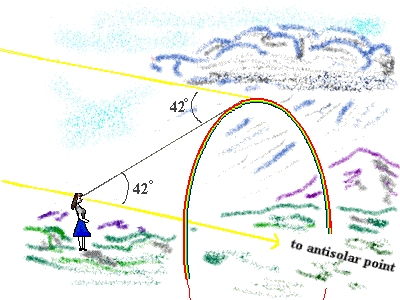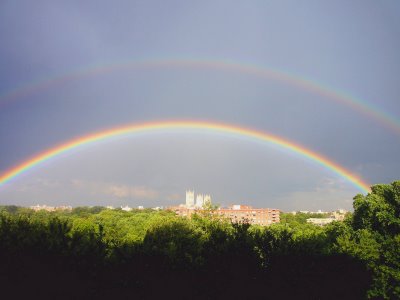Physicist: A rainbow is an angle-dependent illusion. They don’t actually exist anywhere, they just appear to. Since they can only exist at a particular angle (with respect to you and the Sun), you can never see them anywhere else in the sky.
The next time you see a rainbow, draw an imaginary line from the sun through you. You’ll notice that this line goes exactly through the middle of the rainbow. This comes about because of how rainbows are created. No matter where you are, the red line is 138 degrees from the sun and the purple line is 140 degrees from the Sun.
For very small drops of water the surface tension overwhelms all other forces, and the drop is pulled into a nearly perfect sphere (which has nice optical properties). When light encounters the surface of water (or anything at all really) it splits into its component colors. As the light travels into the drop the various colors mostly end up getting scrambled so much that almost anywhere you look you’ll see a more or less even combination of them (white light). However, light that enters the drop, reflects off the back, and leaves again at about 42° from the direction it came from produces colors that stay separated.

The path taken by light through a water drop with one reflection (upper left) and with two reflections (upper right). At 42° the light is not recombined into white light, and thus forms a rainbow. The recombined white light makes the sky under rainbows brighter than the sky above.
This happens again at around 52°, but this time the effect is caused by two reflections inside the water drop. As a result of there being two reflection (instead of one), the colors in secondary rainbows are reversed compared to the primary rainbow at 42°.
Entirely unimportant fun fact: the only way to see a complete, full circle, rainbow is to be flying (or falling). Otherwise whatever you’re standing on will cast a shadow that will cut off the bottom of the circle.









Pingback: Q: If you suddenly replaced all water drops in the sky with same sized spheres of polished diamond, what would happen to the rainbow? | Ask a Mathematician / Ask a Physicist